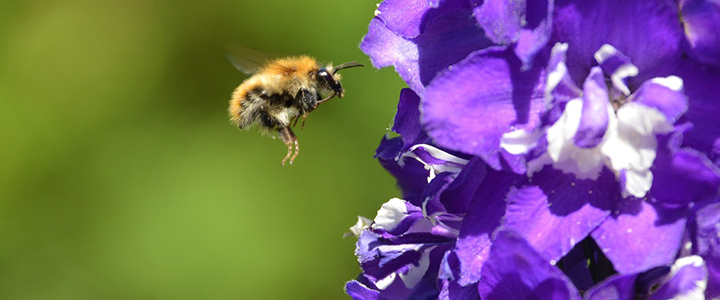
How to BEE Popular with Pollinators: 6 Ways to Attract Bees and Butterflies to your Garden This Summer
Pollinators play a necessary role in our everyday lives. We wouldn’t be able to survive without them! Pollinators include bees, butterflies, moths, beetles and any other insect or animal that moves pollen within flowers. These little guys are responsible for much of our ecological survival. Of the 1,400 crop plants grown around the world, which includes those that produce all of our food and plant-based industrial products, almost 80% require pollination by animals, according to the U.S. Department of Agriculture. Pollinators are critical for our environment and our economy.
Unfortunately, pollinator populations are declining in New Hampshire and North America. Habitat loss, use of pesticides, exotic invasive species and climate change all account for the decrease in healthy pollinators. Due to these declines in population, iconic species like the monarch butterfly and the American bumble bee have been named as Species of Greatest Conservation Need in New Hampshire and other states. But you can help! Pollinator-friendly gardens can support a diversity of pollinators and help maintain the local ecosystem and environment! Here are 6 steps you can take toward creating a pollinator-friendly garden:
Grow native flowering plants
Native plants occur naturally in a specific region and evolve there. Native plants are important to gardens because those plants have co-evolved with the native pollinators. In other words, they just work better together! Exotic invasive species can oftentimes overcrowd native plants and outcompete them for resources. This makes it difficult for the native species to survive and diminishes the preservation of local biodiversity. Native Plant Trust is a helpful website that can assist New England gardeners in finding the right native plants for their specific “ecoregion.” You simply enter your New England ecoregion and characteristics about your garden and let the website determine which native plant would work best for you!
Provide long-lasting blooms
Bees and other pollinators can’t collect pollen year-round, so it is very important for them to use flowering plants in the warmer months as best they can. To reach full potential with a pollinator garden, plan to have blooming flowers from early spring to late fall. Planting a diverse array of flowering plants will have the most positive impact on pollinators throughout the seasons. Sustaining a long flowering season is a win-win situation: the pollinators can partake in the nectar and pollen sources and you and your guests get to continue to enjoy the beauty of the flowers!
Plant in groups
Clumping flowers together in groups not only looks great in a garden, but it is preferred by pollinators as well. Even just a small clump of the right flowers is helpful for the local pollinator community. A cluster of flowers is much easier for pollinators to spot and feast on rather than having to travel all the way across a garden or lawn for a single flower. A few steps for you is like a football field to a small bee! Keeping plants grouped together also means less maintenance work for the gardener as there is less effort needed to tend to them when they are in the same area.
Avoid using pesticides
Pesticides, including those in the class of neonicotinoids, pose a harmful risk to bees and other insects that benefit us. People often use pesticides in their gardens without knowing the harm they cause. With some research and bit of effort, you will find there are many non-chemical approaches that can be used in place of toxic pesticides, such as removing insects by hand, washing pests away using a spray nozzle or setting traps. People who use well water should especially avoid pesticides. Grow Smart, Grow Safe has more suggestions for chemical-free gardening.
If you do continue to use pesticides in your garden, it is very important to be mindful of how you apply it in order to do the least damage. It is best to apply the pesticide after the flower petals have fallen and when bees are less likely to visit. This means do not apply pesticides when the pollinators are flying around. Wait until one hour after sunset and two hours before sunrise. For more information on how to correctly use pesticides or to learn alternatives to pesticide, explore the EPA’s Pollinator Protection webpage.
Get a little lazy
You can actually get away with doing less work in the garden as a benefit to your local pollinators. Did you know that some native bees and pollinators live in the ground? Consider either topdressing your soil with compost and/or leaving some areas with no mulch so they can get in and out of their homes easily. All that plant material that we automatically “clean up” in the fall is actually very important for insects and birds to survive the winter. Consider leaving flower stalks and leaves to provide critical shelter and food for butterflies, bees, bugs and native birds. In the spring, wait for night temperatures to be consistently over 50 degrees to “clean up” the garden and lay mulch. This gives insect eggs time and warmth to hatch and butterfly and moth larvae to emerge.
Get certified!
Once you have your pollinator-friendly garden set up, why not get certified for it? The UMaine and UNH Cooperative Extensions have a garden certification program available for people who are passionate about pollinators! All you have to do is complete the four steps outlined on their website and then fill out the application. Once certified you can purchase a Pollinator-Friendly Garden certified sign for your garden. Proceeds go toward the UMaine and UNH Extension Master Gardener Volunteers so they can continue their quest of educating the public about the importance of pollinators. Having a sign and certification will also serve as inspiration for you to continue maintaining a functional garden and to help spread the word about how pollinators are the bees-knees!




